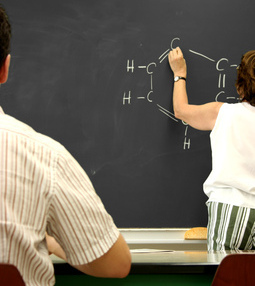Abbreviations and Acronyms in Biochemistry
Biochemistry is a field with lots or actors: proteins, DNA sequences, ligands
etc. So, there is a neccessity to give name to a lot of molecules. In early
times molecules were given proper names: e.g. actin, or myosin. Nowadays names
are mainly functional, describing the role or function of the molecule, like
CRE-binding protein (CREB) o poly-A-tail binding protein (PAB protein). These
are longs names, and are referred to by their acronym, usually. Conversely, having a hint of the meaning behind an acronym is very useful to memorize the name and understand the role of the molecule. Thus, a collection of many commonly used abbreviations and acronym names for molecules can be valuable.
Lecture presentations
These presentations have been used in Biochemistry lectures for first year medical students. Old courses and previous versions of the presentations are stored in a separate page.The presentations are shared with a
 Creative
Commons NonCommercial-ShareAlike 3.0 Unported License.
Creative
Commons NonCommercial-ShareAlike 3.0 Unported License. However, these presentations include drawings, photographs and excerpts from copyrighted works by others, under fair use clause. Those elements retain the copyright of the original autors.
Chemical foundations
Biomolecules
Chemical properties of biomolecules, chemical reactions and weak interactions between biomolecules.
Chemical properties of biomolecules, chemical reactions and weak interactions between biomolecules.
Water and acid-base equilibria
Water structure and properties, acids, bases, pH, pKa and buffers.
Water structure and properties, acids, bases, pH, pKa and buffers.
Protein structure and function
Protein structure and folding
Aminoacids properties, peptide bond, protein folding, secondary structures. Higher order structures, protein motives and domains
Aminoacids properties, peptide bond, protein folding, secondary structures. Higher order structures, protein motives and domains
Structure-function: membrane, fibrous and globular proteins
Proteins in solution. Structural characteristics of membrane and fibrous proteins. Globular proteins: hemoglobin.
Proteins in solution. Structural characteristics of membrane and fibrous proteins. Globular proteins: hemoglobin.
Structure-function: enzymes
Chemical kinetics and enzimatic catalysis mechanisms. Enzyme kinetics and inhibition. Regulation of enzyme action.
Chemical kinetics and enzimatic catalysis mechanisms. Enzyme kinetics and inhibition. Regulation of enzyme action.
DNA structure and Molecular biology
DNA, genes and chromosomes
DNA structures, DNA stability, denaturation and hybridization and topology. Structure of chromatin and chromosomes. Genome organization.
DNA structures, DNA stability, denaturation and hybridization and topology. Structure of chromatin and chromosomes. Genome organization.
Replication, repair and recombination of DNA
General aspects of replication, fidelity and procesivity. Replication machinery in eukaryotes. Recombination. Molecular mechanisms of DNA damage. DNA repair mechanisms.
General aspects of replication, fidelity and procesivity. Replication machinery in eukaryotes. Recombination. Molecular mechanisms of DNA damage. DNA repair mechanisms.
Transcription and processing of RNA
General concepts of transcription in bacteria and eukaryotes. Assembly of RNApolII complex. Processing of eukariotic RNA transcript. Nucleo-cytoplasmatic transport. RNA degradation.
General concepts of transcription in bacteria and eukaryotes. Assembly of RNApolII complex. Processing of eukariotic RNA transcript. Nucleo-cytoplasmatic transport. RNA degradation.
Protein syntheis and degradation
Genetic code and aminoacyl-tRNA synthetases. Ribosomes as molecular machines. Post-translational processing of new proteins. Ubiquitin and protein degradation mechanisms.
Genetic code and aminoacyl-tRNA synthetases. Ribosomes as molecular machines. Post-translational processing of new proteins. Ubiquitin and protein degradation mechanisms.
Regulation of gene expression
Bacterial operons. Regulation of chromatin compaction. Eukaryotic transcripction factors, mediator and remodelling complexes. Structure and function of nuclear receptors. Post-transcriptional mechanisms of regulation of gene expression.
Bacterial operons. Regulation of chromatin compaction. Eukaryotic transcripction factors, mediator and remodelling complexes. Structure and function of nuclear receptors. Post-transcriptional mechanisms of regulation of gene expression.
Membrane transport and signalling mechanisms
Membrane transport and bioenergetics
Chemical physics of diffusion and transport. Ionic basis of membrane potential. Ion channels and membrane transporters. Ion pumping mechanisms. Active co-transport mechanisms
Chemical physics of diffusion and transport. Ionic basis of membrane potential. Ion channels and membrane transporters. Ion pumping mechanisms. Active co-transport mechanisms
Signalling mechanisms
Intercellular communication mechanisms and membrane receptors. GPCR and second messenger pathways. RTK related pathways: EGFR and InsR signalling strategies.
Intercellular communication mechanisms and membrane receptors. GPCR and second messenger pathways. RTK related pathways: EGFR and InsR signalling strategies.



 HTML
HTML PDF
PDF ODF
ODF